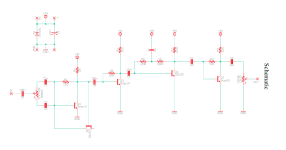ColorMeBaddFann
Member
Anyone out there put together a Night Destroyer by Moonn Electronics (https://moonnelectronics.bigcartel.com/product/night-destroyer) Got it as a "bonus" along with an order (Thanks, Nils!), and from the description its a clone of the Devi Ever Destructo Noctavia octave fuzz. Demo makes the original look pretty gnarly and noisy, so thought it'd be fun to assemble today.
Got everything together and plugged it in, and even when maxed I noticed the level is way below unity of my clean signal. Went through and checked for any bridges and reflowed all joins but still low output. Based on the schematic below, where would be a good place to start investigating? Or is it a case of changing a resistor value somewhere? I do think Q4 is incorrectly oriented on the PCB silkscreen, and rotating the 2N2222 by 180 degrees helped a bit, but still really quiet. Anyone else experience this issue? Thanks!

Got everything together and plugged it in, and even when maxed I noticed the level is way below unity of my clean signal. Went through and checked for any bridges and reflowed all joins but still low output. Based on the schematic below, where would be a good place to start investigating? Or is it a case of changing a resistor value somewhere? I do think Q4 is incorrectly oriented on the PCB silkscreen, and rotating the 2N2222 by 180 degrees helped a bit, but still really quiet. Anyone else experience this issue? Thanks!




